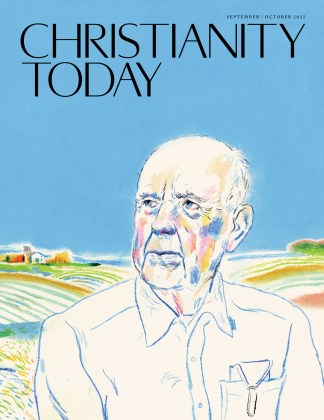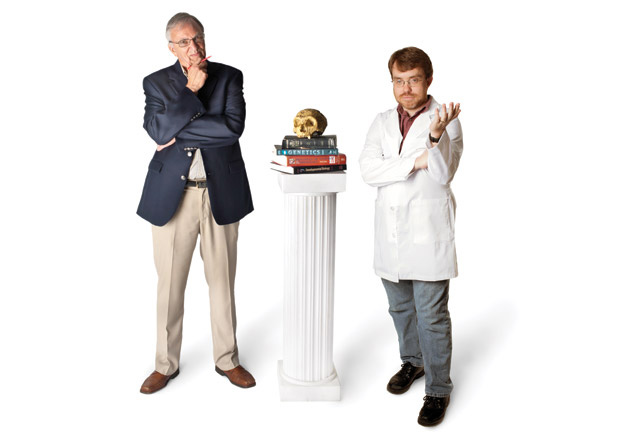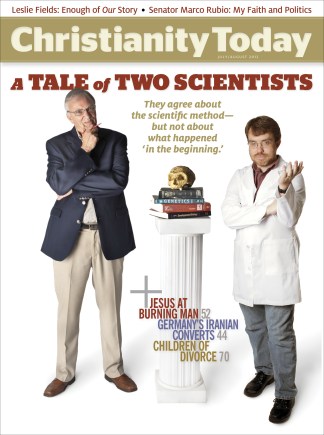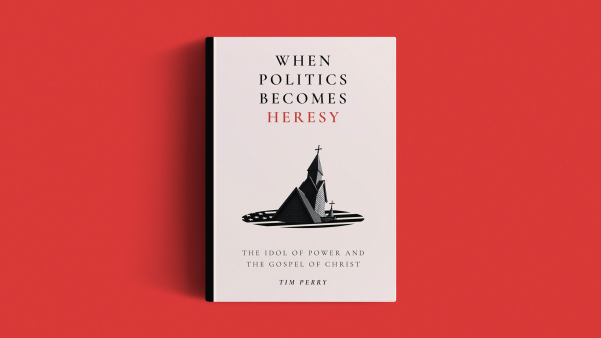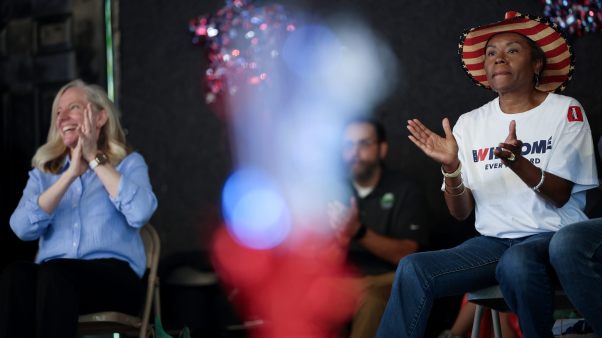Darrel Falk grew up in a “wonderful home and a wonderful church” near Vancouver, British Columbia. A shy, serious child, he had a reputation among his friends for never lying or swearing. He asked Jesus into his heart at age 4, and through an altar call at age 10, asked for a second work of grace, in the holiness language of his Nazarene church. “I feel so clean inside,” he said afterwards in tearful wonder.
Todd Wood was born a generation after Falk in Rives Junction, an unincorporated village in the heart of Michigan. His father was a truck driver, and they lived on 13 rural acres, out of sight of the nearest neighbor. Northwest Baptist, a small, fundamentalist church his parents had helped to start and many relatives attended, was at the heart of his life. He attended a K-12 Baptist school with 25 students in his graduating class. A quiet boy, Wood loved doing research papers, going far beyond teachers’ expectations in tracking down extensive sources. Few in his acquaintance had been to college, and he had never met a scientist.
Both Wood and Falk grew up with absolute confidence in the Bible, a strong sense of family, and a belief that church was the place to find meaning and community. Both of them had an unusual aptitude for mathematics and an interest in science—though neither one had much idea what science was. They could have followed very similar pathways, and in a sense, they did.
But the controversies over evolution within the Christian community have taken the two scientists on very different journeys in a time when common ground on human origins and the Genesis narrative seems to be shrinking.
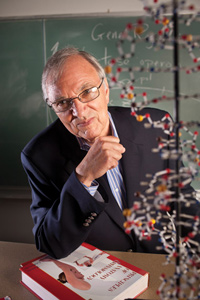
After Literalism
As an introspective and worrying child, Falk occasionally wondered whether Christianity was too good to be true. “I wanted it to be true because it was so beautiful. Jesus was my best friend. I felt very close to God.”
In junior high he encountered a textbook that pictured humans evolving from apes. He didn’t believe it was true—his church read Genesis with a strict literalism—but he feared that it might be and that his faith would be undone. Consequently, he stuck to chemistry and physics through high school in the 1960s. His one biology class never talked about evolution or DNA. After a year at a church Bible college, Falk started at Simon Frazer, Canada’s leading research university, based in Vancouver. He had decided to become a doctor, which meant he had to take biology.
He was completely unprepared for the beauty he encountered. “I had known the beauty of Christianity. Now I discovered the beauty of genetics. When I saw how the cell worked, it was unbelievably beautiful. Thousands of protein molecules, intricately folded, each doing a particular job in the cell. This astonishing process was going on in every one of my trillions of cells, making me who I am. Forty years later, I’m still in love with it. It never gets old, never loses its appeal.”
For Falk, evidence that all of life is related due to common origin was clearly written in the cell. Every organism used the same molecules, the same proteins, the same assembly processes. Even for organisms as different as birds and sea slugs, grass and elephants, similarities at the molecular level jumped out at him. In the church of his boyhood, he found no place for this knowledge or this beauty. He only knew how to read Genesis as six-day history, which he could not reconcile with what enthralled him in the laboratory. The beauty of the cell seemed to him evidence of God’s design and providential oversight. But he had no one to help him rebuild his picture of God’s creation.
His slide away from faith took place later, when he went on to complete his doctoral degree at the University of Alberta. It wasn’t principally because of science. He and his wife attended a church that attracted young people in rebellion against their fundamentalist backgrounds. “Evolution was a side issue. They were questioning everything. Eventually there wasn’t much left of the classical Christianity of my youth.”
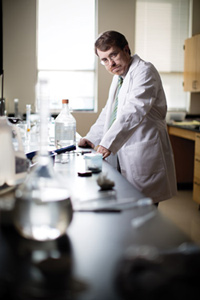
Resisting Evolution
Todd Wood graduated at the top of his high-school class and went on to Liberty University in Virginia, the first of the Woods to attend college. Liberty’s biology department emphasized field studies, and he delighted in the freedom of the woods and waters that he explored as part of his learning.
Quite on his own, Wood found creationist publications in the library, and he soon became expert in the literature. He had read a few creationist books in high school, but the university library opened up a much richer field.
About 30 years earlier, creation science as a movement had been born with the 1961 publication of The Genesis Flood, authored by John Whitcomb and Henry Morris. Whitcomb was an Old Testament professor who read Genesis literally. Morris was a professor of hydraulic engineering fascinated by questions of origins. Together they updated the writings of George Price, a Seventh-day Adventist schoolteacher and amateur geologist who believed that almost all geological formations worldwide had been laid down in Noah’s flood about 4,000 years before. Price’s flood geology attracted limited interest until Morris and Whitcomb popularized it for a wider audience. Morris helped to found the Creation Research Society and later the Institute for Creation Research.
Popular resistance to evolution had a much deeper history, of course. The idea that man and monkeys are related had met a steady stream of humor and invective since the publication of Darwin’s On the Origin of Species in 1859. Creation science, however, was an attempt to build a kind of hybrid discipline of science and biblical interpretation based on the literal reading of Genesis.
Wood loved biology. When his professors explained that graduate schools would pay him to study science, he could hardly believe it. He applied to just one school, the University of Virginia. He was one of five students accepted to begin graduate study of biochemistry in the mid-1990s.
For Wood, creation science could win its argument if it demonstrated that it explained the creation better than an evolutionary model.
But the adjustment to graduate school proved traumatic. “I was blown away, socially and emotionally,” Wood says. “I was completely ignorant of big science and labs of the kind they use. I am amazed they didn’t just throw me out. I was so overwhelmed.”
He rented an apartment far out of town and realized that, on his budget, he could eat just one meal a day. Usually that was a frozen dinner. Only one godsend kept him together in his utter loneliness: Wayne Hills Baptist Church. Wood joined the choir. “That church is why I didn’t quit.”
Moment of Truth
After graduation from Simon Fraser in 1968, Darrel Falk went on to postdoctoral studies at the University of British Columbia. “I thought I was going to be a great geneticist,” he says.
Until key experiments didn’t go well. “I didn’t have much left when people didn’t think I was smart.” As often happens in academia, he sank into despondency.
At this time, a tour of the musical Jesus Christ Superstar came to Vancouver. One day, Falk overheard some of his lab partners discussing it in the department lounge. None of them were Christians. They were pooling their meager knowledge when suddenly one of them turned to Falk, known to be a Christian. “Who were his disciples? Can you name them?”
“I had the strangest sensation when he turned to me, because I recognized that although there was a time when Jesus was my best friend, now he was not only not my best friend but was on the verge of becoming a distant memory. I had not opened my Bible in months. I had no right to be consulted.” Shaken by the realization that he had lost his faith, he was wrenched by the thought of his daughters, ages 1 and 3. “I felt sad for them, that I wasn’t going to be a good father to them, giving them what I had been given. I was 27 years old, and I wanted to be a Christian again.”
A few days later, a Christian professor at the university invited him to lunch. He encouraged Falk that faith and learning were meant to grow together. That night, Falk knelt by his bed to pray, just as he had been taught to do as a child. He offered a classic doubter’s prayer, telling God he was not even sure that he was there, but that he was going to try to live as though he were.
Falk began to read books by Christians that expressed faith in a far deeper way than anything he had previously read—books by journalist Malcolm Muggeridge, theologian Dietrich Bonhoeffer, and Leo Tolstoy, and accounts of Mother Teresa. Privately, his devotion to Christ grew. Publicly, he had no way to express it. Occasionally he attended church but was unsatisfied. He found churches either theologically liberal and impersonal, or else narrow and anti-intellectual. In the first, he missed the warmth and devotion that he treasured from his childhood; in the second, he felt sure he would always be viewed with suspicion.
He took a postdoctoral fellowship in Southern California. On one memorable day, he was at the beach with his family when he saw a church bus arrive in the parking lot. From the lettering on the side, he could see the bus was from a Nazarene church, the denomination of his boyhood. “This church family, I reasoned, was having a picnic, just like I used to love so much.” The sight prompted deep sadness, as he thought of his daughters. They would never go on a church picnic. They would never gain the richest part of his heritage. “I longed to go back, if only for the sake of my daughters. But I could not go back—the chasm that separated us was too great. One of the widest sections of the gulf was my belief in gradual creation.”
Career Suicide
For Wood, laboratory science at a major university was overwhelming. He was not talented as an experimentalist, but his love for research and his mathematical abilities paid off in the classroom.
Computational analysis was just beginning to become a significant part of biology, as decoding the genome offered reams of data that required computer analysis. Wood was at home with this. “It clicked. To this day I get a nice little charge of happiness when I see sequence data.”
He remained very much alone. He didn’t discuss his creationist beliefs; he believed that he was in graduate school to learn, not to argue. “I went in fully aware of the stereotype of creationists as bellicose. I didn’t want to be anything like that.” His professors, he soon realized, were hardly the enemy; they were brilliant men introducing him to a wonderful world where he knew he could thrive.
The first human genome sequence was published the year that Wood began graduate school, providing strong evidence for evolution. The DNA for chimps and humans was virtually the same. Traces of common origins were everywhere: Humans even possessed a broken version of the gene that lizards and birds use to produce eggs. Wood remained fully committed to a six-day creation—he says he never doubted it for a minute—because he saw no other way to read the Bible. But that didn’t keep him from recognizing that evolution had powerful attestation.
While enthralled with biological research, he also became an active participant in the creationist movement, which had taken off, partly due the Internet’s ability to help creationists find each other and engage in ongoing discussion.
Wood joined some of the earliest e-mail discussion lists. As a graduate student at a top-ranked school, he helped refine creationist thinking. Gradually Wood spent less time trying to prove that evolution was wrong. Many of the assertions creationists made were missing the point, he realized, knocking down straw men. More fundamentally, science didn’t move forward by disproving theories but by advancing better ones. Creation science could win its argument if it demonstrated that it explained the creation better than an evolutionary model.
The most obvious fact about created life was its extravagant variety, along with its fundamental similarity at the molecular level. Evolution explained this as the product of gradual variation from some original organism. Creationism explained the same facts as the product of a designer who repeatedly used the same basic designs. But Wood didn’t find that assertion particularly illuminating. It could be applied to any facts that came along, and it didn’t help Wood understand God’s creation more deeply. “I want to understand what God is thinking. Why did he make chimps almost the same as humans?”
As he probed for answers, a small group of biology grad students who had connected via e-mail emerged. They met informally for the first time in 1997 at Bryan College, a small Christian school on a hill overlooking the Dayton, Tennessee, courthouse where the infamous Scopes Monkey Trial took place in 1925.
The group agreed that in order to give a scientific account of creation biology, they first needed to identify the units of God’s creation, the “created kinds” of Genesis 1. They believed that God had created life in certain limited forms, which had since diversified. If they could work backwards to those original forms, they would have the basis for understanding similarity and diversity in today’s life forms. This basic work, known as “baraminology,” would become Wood’s research focal point.
But not yet. After finishing his doctoral dissertation, Wood took a postdoctoral position at Clemson University, part of a team that was decoding the rice genome. The multimillion-dollar grant solidified his dislike for big science. At Clemson, he lived the high-pressure lifestyle that comes with large teams of scientists working under time and budget constraints. Wood remained a solitary character. He loved science when he could explore problems in his own time and in his own way. He didn’t like being a laboratory manager.
After a year at Clemson, Wood did the unthinkable: He applied for a position at tiny Bryan College, to work with creationist geologist Kurt Wise. It was career suicide, but Wood did it with a sense of grateful calling. Finally, he would have time and opportunity to work at science in the way he believed in.
A Robust Faith
Following his research assignment in Southern California, Darrel Falk gained a tenure-track position at Syracuse University. This constituted real success.
But he was stymied in his reviving faith. He and his wife visited several churches in Syracuse, finding none that offered the deep devotion they craved.
As a last-ditch effort, he drove across town one Sunday morning to visit a small Nazarene church. Six months before, he and his wife had driven to this same church just to park on the street and watch people leaving. They had seen people taking time to speak warmly; they had noticed two girls about the same ages as their own—were they the pastor’s daughters? Maybe we can go here, they had thought. But as the week went on they decided no, they shouldn’t get their hopes up. There was too much pain in the thought of rejection.
Now, Falk went alone, like a spy, into the church for a worship service.
After the service, he found himself surrounded by friendly faces. They seemed delighted that he was a professor at Syracuse. Falk went home and told his wife, “We might have a church after all.”
So it proved to be. Though the church certainly didn’t believe in evolution, and came to know that Falk did, they never bothered about it. “That church, God’s gift to us, built a bridge to us and welcomed us just as we were, gradual creation perspective and all.” The pastor helped Falk as he found his way to a fuller, more robust faith, eventually asking him to teach a Sunday school class for young adults.
Falk also worked hard to build a Christian fellowship among faculty and grad students at Syracuse. Working on the genetics of the fruit fly, Falk gained tenure. He loved teaching. Gradually, though, he began to long to work at a Christian community. Through a series of dramatic answers to prayer, he looked for a position at a Christian college. He went to Mount Vernon Nazarene in Ohio for four years before landing at Point Loma Nazarene in San Diego.
The Tidal Wave
Eleven years before Todd Wood arrived at Bryan College in Tennessee, the school had established a creation research center. The director was Kurt Wise, a brilliant, Harvard-trained paleontologist who had pushed the initial concept of baraminology.
A computer was all Wood really needed to do fundamental analysis of “created kinds.” That was a good thing since the tiny institute had no lab, virtually no research funds, and only one research assistant. Wood began to do careful statistical analysis of data drawn from published scientific reports. He hoped to find distinct groupings within a cross-section of species; a cluster might represent one of the “created kinds” of Genesis 1. (For example, foxes, wolves, dogs, and coyotes, while distinct species, might represent the divergent offspring of a single pair from Noah’s ark. Many young-earth creationists believe in very rapid evolution of species since the great flood, thus creating the immense diversity of species we see today.)
Falk only knew how to read Genesis as six-day history, which he could not reconcile with what enthralled him in the laboratory. He had no one to help him rebuild his picture of God’s creation.
“I want to redeem science,” Wood says. “I don’t want to refute science.” Many creationists focus on apologetics, which needs convincing answers. Wood wants to do science, which is more invested in asking the right questions. Wood believes that the questions he poses based on his reading of Genesis will lead to greater illumination.
Meanwhile, at Point Loma Nazarene University Falk found a wholesome, faith-filled environment eager to discuss how faith and science could work together. There was controversy in the Nazarene denomination—one biology teacher, Richard Colling, lost his job at a sister school, Olivet Nazarene University. But Point Loma took the lead in stimulating dialogue.
Beginning in the summer of 1991, Falk joined in a multidisciplinary faculty discussion group that read books together and talked through many areas of faith and science. After years of discussion, he felt that he should write a book aimed at students, explaining to them how biologists see the world. He tried writing a chapter, but it was stiff and awkward. One student who read it said, “If you could only write like you teach!” Falk put the idea aside and shortly afterward became associate provost and a dean at the university*.
While in that position, administrators asked him to talk to a young-earth creationist who was volunteering to teach science classes. Point Loma had no courses on either evolution or creation, and the volunteer teacher aggressively pushed for his position. “You’re going to have to deal with this issue,” he said. “A tidal wave is going to come.”
“I felt we had nothing to point to that says, ‘here’s what we believe,’ ” says Falk. So he returned to his writing, pretending he was in his classroom teaching genetics or comparative anatomy, answering questions posed by students.
When he had a manuscript, he offered it to students for their reaction. One showed it to a parent, who copied it and sent it to denominational leaders and others. The same parent later wrote to the college’s president with a series of accusations, demanding a response. Falk responded as graciously as he could. The parent was not satisfied; he accused Point Loma of deliberately destroying young people’s faith. It became a crusade, pulling in pastors and higher denominational officials. Finally, in the fall of 2000, the college president called Falk in and showed him a detailed, multiple-page letter from Focus on the Family founder James Dobson.
Dobson is a Point Loma graduate—one with great influence over evangelicals. Falk composed an 11-page response to Dobson’s letter, and was invited to a nail-biting summit with Dobson in Colorado Springs.
“The key accusation,” Falk says, “was that I was destroying the faith of my students.” He asked 31 students to write anonymously about the role of the Biology Department in their faith. Almost all wrote very positively. He took those letters to Dobson. To Falk’s great relief, the meeting went well, ending in a cordial agreement to disagree.
In Coming to Peace with Science, Falk lays out the evidence for an ancient earth and the gradual development of its creatures over millions of years. He speaks of the message of Genesis—indeed, the whole of Scripture—as a testimony to God’s goodness and his plan to save the world. However, “I expect that many persons in our churches will read this book and put it down still believing in sudden creation. From my perspective, that will be fine. My prayer is that each person who reads it will respect that one should be able to be accepted as an equal partner in Christ’s body even if he or she believes that God created gradually.”
In recent years, Falk has found a new role through interactions with Francis Collins, the world-famous geneticist who headed the human genome project and now leads the National Institutes for Health (NIH). After publishing the bestselling book The Language of God, Collins received so many e-mailed questions that he decided to create BioLogos, a small organization to help answer them. But when Collins was asked to head the NIH, Falk, already involved, took over as president of BioLogos.
Under Falk’s leadership, BioLogos has emerged as an important group of Christians advocating “evolutionary creation.” Falk has held to his plea for Christians to love and respect each other while advocating different points of view. In bearing this out, BioLogos recently invited a number of Southern Baptist biblical scholars to publish essays critical of the BioLogos perspective on the BioLogos website, in order to foster mutual understanding.
“We must be patient with each other and allow each other to follow truth as we see it in Scripture,” Falk wrote. “We must recognize that we will never reach the point where we all see Scripture the same way. When there is division in the church, it will be difficult for the thirsty to find their way to Jesus.”
Unanswered Questions
At Bryan University, Todd Wood’s office is located in the science museum, a small and eclectic collection of fossils, animals preserved by taxidermy, dead snakes coiled in bottles, and other science arcana.
Anna, a student, approaches Wood to discuss her research project. “Do you have ‘R’ on your computer?” Wood asks. She has no idea what “R” is—a computer program for analyzing statistical data—and he instructs her on downloading it. Then he walks her through her project while she takes word-for-word notes on her laptop.
‘I want to understand what God is thinking. Why did he make chimps almost the same as humans?’ – Todd Wood
It has to do with analyzing the ratios between two kinds of genetic mutations, transitions and transversions. Wood has noticed that the ratio between the two varies by organism, and he wonders whether this could signal a different “created kind.” In a previous research project, Anna looked at the fossil record of flowering plants. Since most fossils were laid down in Noah’s flood, according to six-day creationists, these fossils should be close to the original created kinds. The idea for Anna’s project is to check whether these “created kinds” might also show their differences in the ratio of transversions to transitions.
“If you look at all the flowering plants,” Wood says, “sunflowers to lilies to oak trees, very different plants, you find that their genes are almost the same. It’s challenging. How do we draw the line, and where do we draw it? If we’re ignoring 97 percent of the data, does the line mean anything? Evolutionists would say we are grasping at straws. But it’s possible that the differences may harbor a signal.” Wood discusses with Anna some of the statistical issues. For example, “the sample size could be a meaningful problem” as Anna zeroes in on particular families of flowers. “It’s good to be aware of these details so we don’t go off and prematurely claim that we have solved the problem of identifying the created kinds.”
Anna is doing serious scientific research, but it’s impossible to miss that Wood leads only handfuls of undergraduates like her without laboratory equipment or funding. Compared with thousands of high-tech research labs filled with scientists, it’s a pea shooter facing the U.S. Army.
Wood is not daunted. In order to be a young-earth creation scientist, you have to be stunningly independent. Wood worries that no new generation is rising up to advance creation science. “I’m searching for someone willing to help me develop the next generation of baraminology.” At the same time, he’s less and less interested in fighting against evolutionary creationists. “I’m beginning to think the war is detrimental to the church.
“We all have enormous unanswered questions, whether scientific or biblical. We all see through a glass darkly.”
*Correction: An earlier version of this story erroneously stated Falk’s position at Point Loma University.
Tim Stafford is senior writer for Christianity Today.
To read the best Christianity Today articles on creation, evolution, and intelligent design, check out our latest eBook, The Origins Debate, at CTeBooks.com/ct/origins-debate. For more, check out our explanation of “The Evolution of the Debate” and “Illustration: America’s View on Evolution and Creationism.”
